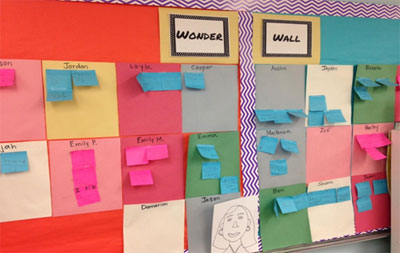
Five Steps to Enhance Learning in the Classroom

Every great teacher wants their students to find joy in the learning process. How do we as educators provide students an environment to discover who they are, help them unlock the passions they hold, and guide their journey of self-discovery while also teaching our mandated curriculum?
The answer is simpler than you might imagine: provide time for students to explore their passions.
“If you can’t figure out your purpose, figure out your passion. For your passion will lead you right into your purpose.” -- Bishop T. D. Jakes
Devoting a portion of work time to exploring passions is not a new concept. Almost 70 years ago, 3M encouraged their employees to devote 15% of their work time to research and create innovative projects that captured their interests and passions. Google did something similar when they encouraged their engineers to take 20% of their time to work on something company-related that interested them personally. Both companies valued a spirit of innovation and productivity; allowing employees to be creative resulted in the creation of such products as post-it notes.
This concept of intentional time spent on projects of interest is foundational to the Genius Hour movement in education, where students spend one hour a week researching their passions and sharing their insights. While an hour a week may seem like an impossible sacrifice in the face of packed pacing guides and scheduling constraints, creative teachers across the world are using this model to bring joy back into their classrooms.
Last year, a first grade teacher and I decided to jump in and try “Passion Projects” to help her students find joy by exploring topics that intrigued them. We mapped out a reasonable timeline to ensure we still had time for the required curriculum. We made sure we set reasonable expectations and planned for explicit time to help students narrow down the scope of their project. Since Passion Projects would be completed during the school day, we worked to anticipate any challenges, such as non-readers doing research, and plan for support before we began.
While we wanted students to show their learning in whichever ways they found most effective, we quickly discovered that six- and seven-year-olds need a bit more structure than older students. Since this was the first “project” many students had every attempted, we decided all students would make a multimedia project using Pixie, a software program installed on every computer which many students had used before. Each child would research their passion and use Pixie to create a digital background image, complete with voice narration, to share their learning.
Once our planning was done, it was set our students loose on their Passion Projects! Following are the five steps we used to guide our students’ work.
Before we introduced anything to the students, we brainstormed our own passions together, talking about things that made us happy, and exploring the “what-ifs” of being educators. “What if we could teach anything we wanted?” “What if we didn’t have to worry about discipline problems?” “What if we could take time to read and learn about our OWN passions during the work day?”
The more we talked about our passions, the more excited we became! Rather than being inundated with logistical worries, we were empowered by the potential of “What if?” This is what we wanted our students to feel: excitement…passion…and the pure joy of learning simply for the sake of learning.

Students began their work by coming up with a list of things that made them happy, and we encouraged them to identify areas about which they wanted to learn more. We used pencils and paper to create our Wonder Wall, but you might prefer to incorporate technology by using a digital tool like Padlet.
To make the Passion Projects manageable, we asked students to narrow their focus to one question they wanted to explore. We added their questions to a shared spreadsheet on Google Drive to keep everything organized and worked together to add resource links and additional information as we guided students through the research process.
To provide support and guidance during this lengthy process, we used a once-a-week two-station rotation. Students either worked with classroom teacher support to read and take notes in their writing journals, or they worked with me, the instructional technology specialist, to design their project to share using Pixie. This approach also allowed time for content integration.
We encouraged students to use both low-tech and high-tech research options. Many students found the answers to their questions in library books. Others used alternate forms of informational text like tourism brochures. When Internet research was required, students used appropriate information resources, such as videos showing how to make books or steps to build a specific Lego figure. When online texts seemed to be too advanced for emerging readers, we used screencasting tools to record ourselves reading the articles and shared the recordings with students through our district's network and shared cloud storage.
As students transitioned from research to creation, we noticed a change in the classroom culture. We had fewer discipline problems and students were engaged with their research and putting more effort into their reading and writing. They were excited about their own digital creations and were helping their classmates who needed assistance...all with smiles, laughter, and joy!
We continued our weekly station rotations until the digital backgrounds were complete. Students then started individual recordings to share what they had learned about their passion. Students who were not busy recording kept working to edit their stories and worked on other tasks.
Students showcased their work with an authentic audience of classmates, teachers, parents, and administrators at a Passion Project Share Fair. As guests walked from laptop to laptop, listening to the student presentations, they validated the time and effort students had put into their work and were able to clearly see how each student had come to realize the joy of learning through the exploration of their passions.
To extend the project beyond the concrete walls of our classrooms, we also created a Passion Project website and shared the links on Twitter and Facebook. When students realized their projects were being viewed by people all across the world, they took even more pride and care in their work and asked, “Can we do this again?”
This year, I’m collaborating with a fourth grade teacher to engage students in Passion Projects devoted to kindness and making the world a better place. Following the same five steps, we are weaving “A Passion for Kindness” through language arts, no-break days, and rainy recess time. We are deliberately planning school time for students to embrace their passions and find ways to utilize their skills and learning to benefit others, giving the sharing portion even more purpose.
Passion Projects capture the joy of learning while integrating content areas of reading, writing, and oral communication and can change the climate of the classroom. Using technology to create, instead of merely consuming, gives students opportunities to showcase their creativity and celebrate their hard work.
If you are looking for a way to bring JOY — Jubilant Outcries of Yes — to your classroom, Passion Projects will do just that.

Follow us on Instagram for daily inspiration

Create a thought web, cluster, flowchart, or other graphic organizer for a lesson
8 first projects to get students using technology
Creative, digital book reviews
Fun and powerful ideas with animated characters

Wixie
Share your ideas, imagination, and understanding through writing, art, voice, and video.

Rubric Maker
Create custom rubrics for your classroom.

Pics4Learning
A curated, copyright-friendly image library that is safe and free for education.

Wriddle
Write, record, and illustrate a sentence.

Get creative classroom ideas delivered straight to your inbox once a month.
Topics